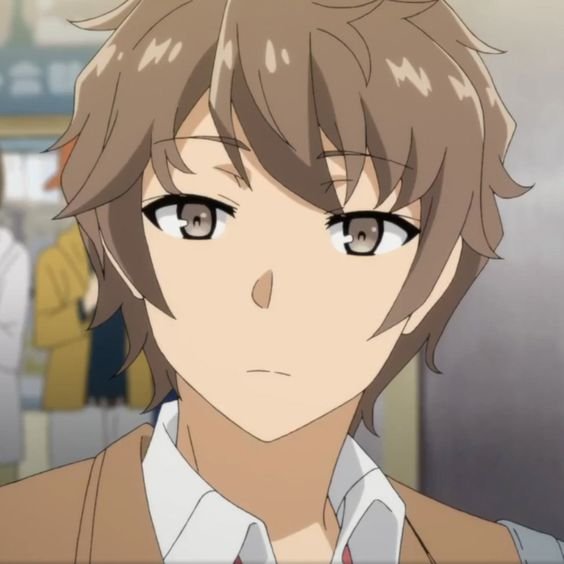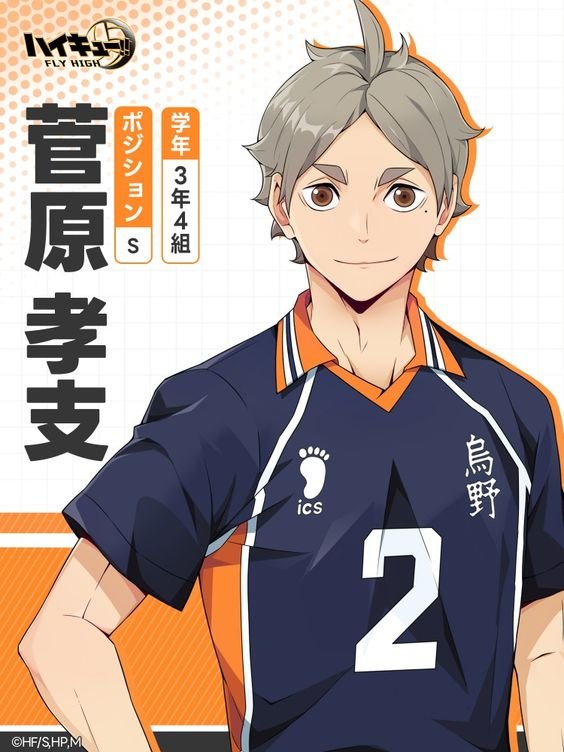
Sakuta Azusagawa
Sakuta Azusagawa |
|
|---|---|
 |
|
| Kana: | 梓川 咲太 |
| Rōmaji: | Azusagawa Sakuta |
| Characteristics | |
| Age: | 17 |
| Gender: | Male |
| Height: | 5’8″ (173 cm) |
| Personal Status | |
| Status: |
Alive |
| Birthdate: | April 10, 1997 |
| Occupation: |
|
| Year: |
|
| Affiliation: |
|
| Relationships: |
|
| Debut | |
| Anime: | Episode 01 |
| Light Novel: | Volume 01 |
| Manga: | Chapter 01 |
| Portrayal | |
| Japanese: | Kaito Ishikawa |
| English: | Stephen Fu |
| “ | ” | |
|
— Sakuta Azusagawa
|
||
Appearance
Sakuta is a young man of average height with a lean build, brown hair, and brown eyes. Notably, he bears three claw-like scars across his chest, remnants of his struggle with Adolescence Syndrome. These scars tend to reopen during intense emotional moments, such as those triggered by Kaede Azusagawa’s own experiences with Adolescence Syndrome.
His school attire includes a white dress shirt under a light-brown blazer, typically left unbuttoned, paired with a red tie. He completes the look with blue pants and brown outdoor shoes, adhering to his school’s uniform.

Sakuta’s full appearance in school uniform.

Sakuta’s full appearance in winter outfit.
Personality
Sakuta’s defining trait is his unwaveringly calm, deadpan expression and straightforward speech, regardless of his emotional state. He is naturally stoic and often voices his thoughts openly, maintaining a composed demeanor. Due to his experience with Adolescence Syndrome, Sakuta is somewhat isolated and indifferent to social acceptance, showing little concern for fitting in with his peers. Although he claims he isn’t bothered by others’ opinions, he admits that certain rumors can still be painful. His detachment stems from a belief that challenging the “atmosphere”—the social norms and hierarchy of school—is futile. Even so, he stands firm in his values, stating that he wouldn’t care if the whole world disliked him, as long as there was one person who truly needed him. This resolve drives him to defy social norms when he feels it’s right.
Beneath his reserved and somewhat antisocial exterior, Sakuta is compassionate, especially toward those facing difficulties, such as his sister and others struggling with Adolescence Syndrome. He shows a quiet kindness, standing by those he cares about, even if it means going against the crowd.
Despite his typically calm and serious nature, Sakuta has a playful, teasing side. He often makes blunt, lightheartedly lewd remarks, especially to his girlfriend, Mai, and friends Rio and Tomoe. These comments are intended as jokes, adding humor rather than offense.
In summary, Sakuta is a complex blend of selflessness, kindness, and wit. He’s blunt and honest, especially with Mai, with whom he shares a mutual love for teasing and sarcasm. Both are quick-witted, compassionate, and deeply supportive of each other. Sakuta’s combination of snark and genuine kindness ultimately reflects his commitment to doing what’s right and supporting those he loves.
Background

Sakuta sustains unexpected injuries.
Sakuta lived a typical life with his family until a traumatic incident two years before the events of the first novel. One night, his sister Kaede came to him deeply distressed after experiencing online bullying. Suddenly, mysterious self-harm cuts appeared on her face and body, seemingly without cause. When Kaede awoke the next morning, she had no recollection of her past, and doctors later diagnosed her with dissociative identity disorder. Despite Sakuta’s attempts to connect with her over the following days, new scars continued to surface around her face and neck. The strain took a toll on their family, particularly their mother, who began to suffer from a mental breakdown as the situation intensified.
The day after witnessing his mother’s breakdown, Sakuta himself woke up with three severe claw-like wounds on his chest and was admitted to the hospital. When he shared his experience, doctors dismissed his account and even suggested he might have been responsible for his injuries. Determined to find a way forward, Sakuta left the hospital on his own and visited Shichirigahama Beach, where he encountered a girl named Shoko Makinohara. When he asked her why she believed his story, Shoko simply said that she wanted to live her life with greater kindness. Inspired by her perspective, Sakuta asked if he, too, could adopt this approach, and she encouraged him.
Upon his discharge, Sakuta gave Kaede a pen and notebook, suggesting that she start writing her name in hiragana, symbolically acknowledging her as the “new” Kaede. To empathize with her struggles and prevent further harm, he later discarded his phone in the ocean, distancing himself from the pressures of social media.
However, rumors soon spread that Sakuta’s hospitalization was the result of violent behavior, ultimately leading to the infamous “Hospitalization Incident.” This event became the basis of false rumors about him, casting a shadow over his reputation at school.
Relationships

Sakuta encounters Mai for the first time.
Mai Sakurajima
Mai is the first person Sakuta meets who suffers from Adolescence Syndrome since his sister Kaede, and she becomes a pivotal figure in his life. Sakuta initially encounters her dressed as a bunny girl in the library, realizing that he is the only one who can see her. Though Mai is a famous actress on hiatus, the syndrome has caused others to ignore or forget her entirely. Curious and empathetic, Sakuta proposes Adolescence Syndrome as the reason for her invisibility, and though she is skeptical, she eventually grows to trust him as her condition worsens.
Mai’s visibility continues to fade, ultimately rendering her unseen even by her mother. Determined to help, Sakuta travels with Mai to Gifu Prefecture, hoping that in a different place, she might be recognized, but their attempts prove unsuccessful. During the trip, Sakuta stays awake to prevent forgetting her, yet she eventually tricks him into falling asleep by spiking his coffee. As a result, he temporarily loses his memory of her, but it soon returns, leading him to publicly proclaim his love at school in an audacious attempt to make her visible again. His confession works, and Mai reappears, though she rebukes him for his dramatic approach.
As their relationship progresses, Mai and Sakuta grow closer despite the challenges posed by her busy career. Although her jealousy flares up occasionally when other girls approach Sakuta, he remains devoted, and they continue to support each other through life’s ups and downs.

Sakuta offers comfort to Kaede after she steps outside.
Kaede Azusagawa
Sakuta shares a unique bond with his younger sister, Kaede, who developed a new personality after being tormented online and subsequently diagnosed with dissociative identity disorder. Their relationship deepened when Sakuta became her primary support, particularly after their parents struggled to cope with her condition. They moved into an apartment together, where Sakuta patiently helps her rebuild her life.
In a courageous step, Kaede sets a series of personal goals, like speaking with others on the phone and attempting to attend school. Despite her struggles, she finds strength in Sakuta’s encouragement. One night, he takes her on a special outing to her future school, a touching moment that brings them closer. Eventually, Kaede regains her former memories, causing Sakuta immense emotional pain as he copes with the loss of her alternate self. Yet, upon reading her notebook, “old” Kaede expresses gratitude for Sakuta’s support, recognizing that she no longer feels alone.

The Azusagawa siblings reflect on Kaede’s old classroom.
Shoko Makinohara
Sakuta first meets Shoko at the beach shortly after his own traumatic experiences, and her empathy leaves a lasting impact on him. He is so moved by her kindness that he chooses to attend her high school in hopes of meeting her again, only to find that she never attended. Later, a younger Shoko appears, caring for a stray cat near Sakuta’s home, though she never acknowledges knowing him.
An older Shoko reappears after Kaede’s memory returns, helping Sakuta understand the inevitability of change. Through her interactions, Sakuta discovers that the older Shoko is from a future timeline where Sakuta died in an accident and saved her life through organ donation. However, when Mai sacrifices herself to protect him, another Shoko intervenes, allowing him to go back and change events so that neither Sakuta nor Mai dies. This timeline reset ultimately saves Shoko’s life, allowing her to move forward without the sorrow of Sakuta’s passing.

Sakuta receives a kick from Tomoe Koga.
Tomoe Koga
Sakuta Azusagawa meets Tomoe Koga in a hilariously unexpected way when she mistakes him for a threat and swiftly delivers a kick to his midsection. This comical introduction sets the stage for a unique relationship as they quickly discover they are trapped in a time loop, reliving the same day over and over. This bizarre predicament draws them together, with Tomoe feeling overwhelmed by social pressures from her peers. In a moment of vulnerability, she asks Sakuta to pretend to be her boyfriend, seeking comfort and support as they navigate their unusual circumstances. Despite the humor in their situation, their bond deepens, with Sakuta providing Tomoe the encouragement she needs to face her insecurities head-on.

Enjoying the fireworks with Futaba and Yuuma.
Rio Futaba
Rio Futaba is one of Sakuta Azusagawa’s closest friends, known for her rational and scientific thinking, which initially leads her to be skeptical of the phenomenon known as Adolescence Syndrome. However, her perspective undergoes a dramatic transformation when she becomes a victim of the syndrome herself, experiencing a profound split into two distinct versions of herself. One version grapples with self-image issues, driven to seek validation through posting revealing photos online, while the other retreats into a shell of self-doubt, isolating herself from others and struggling to find her place in the world. This internal conflict creates a fascinating dynamic as both versions of Rio navigate their feelings of inadequacy and insecurity. Throughout this challenging ordeal, Sakuta steps in as a steadfast support system, offering his understanding and encouragement to both sides of Rio. With his guidance, they learn to confront their fears and insecurities, ultimately helping them to reunite and embrace their identities as a single, whole person. This journey not only allows Rio to accept herself fully but also strengthens her bond with Sakuta, highlighting the importance of friendship and self-acceptance in overcoming personal struggles.
Nodoka Toyohama
Nodoka’s body swap with her half-sister Mai is one of the stranger cases of Adolescence Syndrome that Sakuta encounters. While in Mai’s body, Nodoka struggles with her own insecurities, but Sakuta’s encouragement and a heartfelt moment with Mai help her confront her feelings. Their bond strengthens, and she becomes an occasional presence in Sakuta’s life, helping him celebrate important milestones and navigate challenges with Mai.
Yuuma Kunimi
Yuuma is Sakuta’s only close male friend and one of the few who disregards the rumors surrounding him. Though Yuuma has a girlfriend, Sakuta is aware of Rio’s unspoken feelings for him, navigating the friendship with understanding and discretion. They often work together and share a reliable camaraderie that provides Sakuta with a grounding influence amid his complicated relationships.
Etymology
- 咲 (saku), meaning “to blossom,” which symbolizes growth and resilience.
- 太 (ta), which translates to “thick” or “big,” suggesting strength or a substantial presence.
Together, “Sakuta” conveys the idea of a “strong blossom,” reflecting his ability to thrive despite challenges.
The surnameAzusagawaconsists of:
- 梓 (azusa), referring to the catalpa tree, known for its durability and beauty.
- 川 (kawa/gawa), meaning “river” or “stream,” representing flow and continuity.
Thus, Azusagawa evokes images of a resilient tree by a flowing river, symbolizing the ongoing journey of life and the adaptability that Sakuta demonstrates throughout his experiences. Additionally, Azusagawa is the name of a real river in Matsumoto, Nagano Prefecture, further grounding his character in a natural and cultural context.